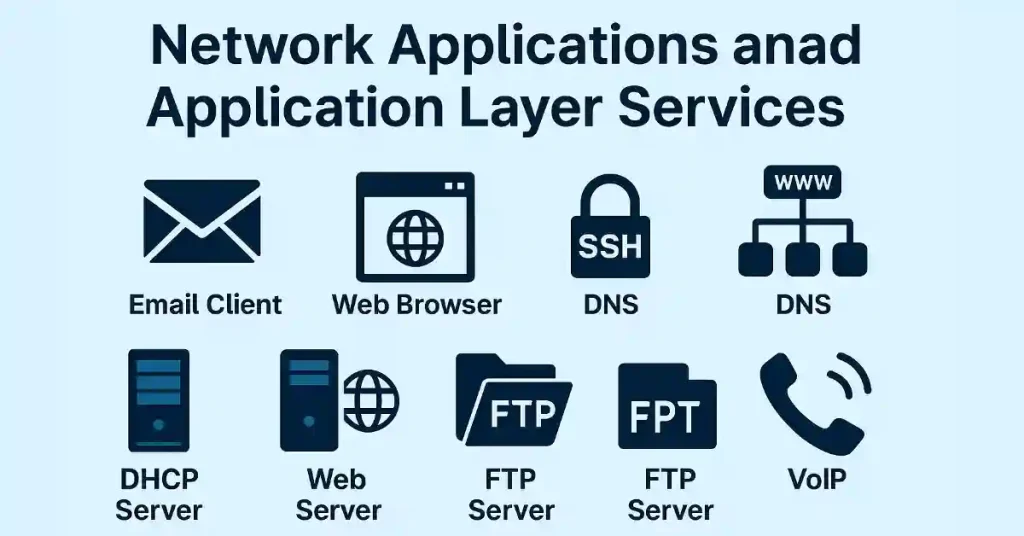Network Applications and Application Layer Services for CCNA/CCNP Success (Updated 2025)
Network applications and application layer services are critical components of modern networking, forming the backbone of communication in enterprise and cloud environments. For CCNA and CCNP students, understanding these concepts is essential for mastering the application layer of the OSI model, a key topic in Cisco certification exams. Network applications, such as email clients and web browsers, communicate directly over the network, while application layer services, like DNS and DHCP, facilitate resource access and data transfer. This article explores these technologies, their protocols, Cisco-specific implementations, and troubleshooting techniques to help you excel in your studies and real-world networking tasks.
Network Applications
Network applications communicate over the network. Some end-user applications apply application layer protocols and can communicate directly with the lower layers of the protocol stack. For example, Email clients are network applications.
Application Layer Services
Network print spooling and file transfer over the network are requisite application layer services for using network resources. These services are the software programs that interface with the network and organize the data for transfer. Several types of data, e.g., text, graphics, audio, and video, are wanted different network services to ensure the data is ready for processing.
Each application or network service uses protocols describing the data standards and formats. There is no way to format data without standard network protocols. Before understanding the role of network services, understanding protocols is very important. In the Windows operating system, we can view the current application, services, and running process, as shown in the above figure. The following are the standard protocols used in networking:-
Domain Name System (DNS)
The Domain Name System (DNS) is a distributed database that translates human-readable domain names (e.g., www.example.com) into IP addresses (e.g., 93.184.216.34). For CCNA/CCNP students, understanding DNS is crucial for configuring and troubleshooting network connectivity. DNS operates as a hierarchical system with root, top-level domain (TLD), and authoritative servers. Key DNS record types include:
- A: Maps a domain to an IPv4 address.
- AAAA: Maps a domain to an IPv6 address.
- CNAME: Aliases one domain to another.
- MX: Specifies mail servers for a domain.
Cisco Configuration Example
To configure a Cisco router as a DNS client:
Router(config)# ip name-server 8.8.8.8 Router(config)# ip domain-lookupTroubleshooting DNS
Use the following commands to verify DNS resolution:
Cisco IOS: ping www.example.com
Windows/Linux: nslookup www.example.com
Secure Shell (SSH)
Secure Shell (SSH) is a secure protocol for remotely managing network devices, replacing the insecure Telnet protocol. SSH uses encryption to protect data during transmission, making it a standard for CCNA/CCNP professionals. It allows network administrators to access and configure devices like Cisco routers and switches securely.
Cisco SSH Configuration
To enable SSH on a Cisco device:

Troubleshooting SSH
Test SSH access: ssh -l admin <router-ip>
Verify SSH is enabled: show ip ssh
Check connectivity: ping <router-ip>
Email Servers (SMTP, POP3, IMAP)
Email servers use protocols like SMTP (Simple Mail Transfer Protocol), POP3 (Post Office Protocol version 3), and IMAP (Internet Message Access Protocol) to send and receive emails. For CCNA/CCNP students, understanding these protocols is vital for configuring and securing email services.
| Protocol | Port | Function | Key Features |
|---|---|---|---|
| SMTP | 25 | Sends emails | Push-based, no email storage |
| POP3 | 110 | Retrieves emails | Downloads and deletes emails from server |
| IMAP | 143 | Retrieves emails | Syncs emails, supports multiple devices |
Cisco Email Security Appliance (ESA)
Cisco ESA provides advanced email security, including spam filtering and encryption. Configure ESA to protect email traffic:
esa> smtproutes esa> routeconfig Troubleshooting Email
- Test SMTP:
telnet smtp.example.com 25 - Verify open ports:
netstat -a(Windows) orss -l(Linux)
DHCP Server
DHCP is the service that automatically assigns the IP address, subnet mask, default gateway, and other information to clients.
Web Server
Web servers transfer information and data between web clients and web servers. The majority of websites are accessed through HTTP (Hypertext Transfer Protocol)
FTP Server
The FTP service allows the download and upload of files between a client and a server.
Voice and Video Applications
Streaming media is very important for businesses to communicate with customers and business partners. The network administrators must care about the equipment configuration and installation and ensure it meets the requirements of real-time applications. The administrator also determines whether the present switches and cabling can support the traffic that will be added shortly.
Voice over IP (VoIP)
Voice over IP (VoIP) enables voice communication over IP networks, using protocols like SIP (Session Initiation Protocol) and RTP (Real-Time Transport Protocol). For CCNA/CCNP, understanding VoIP configuration on Cisco Unified Communications Manager (CUCM) is key.
Cisco VoIP Configuration
To configure a VoIP dial peer on a Cisco router:
Router(config)# dial-peer voice 1 voip Router(config-dial-peer)# destination-pattern 1234 Router(config-dial-peer)# session target ipv4:192.168.1.100 Router(config-dial-peer)# codec g711ulaw QoS for VoIP
Ensure low latency with QoS:
Router(config)# class-map match-all VOIP
Router(config-cmap)# match protocol rtp
Router(config)# policy-map QOS-POLICY
Router(config-pmap)# class VOIP
Router(config-pmap-c)# priority 256
IP Telephony
In IP telephony, the ATA adapter is no longer required because the IP phone itself performs the voice-to-IP conversion. IP phones also use a separate server for call control and signaling.
Real-time Applications
A real-time application is a software program that works within a time frame the user senses as current. This software uses the Real-Time Transport Protocol (RTP) and Real-Time Transport Control Protocol (RTCP).
The QoS mechanism controls the latency of less than a defined value, usually measured in seconds. For example, video conferencing applications, online gaming, and video chatting are Real-time applications.
Troubleshooting Tips
If a server fails, use ping server_ip (Windows/Linux) or tracert server_ip (Windows)/traceroute server_ip (Linux). For P2P connectivity issues, check with netstat -a (Windows) or ss -l (Linux), as applicable.
FAQs
Network applications (e.g., email clients, web browsers) directly communicate over the network, while application layer services (e.g., DNS, DHCP) facilitate network resource access and data transfer.
